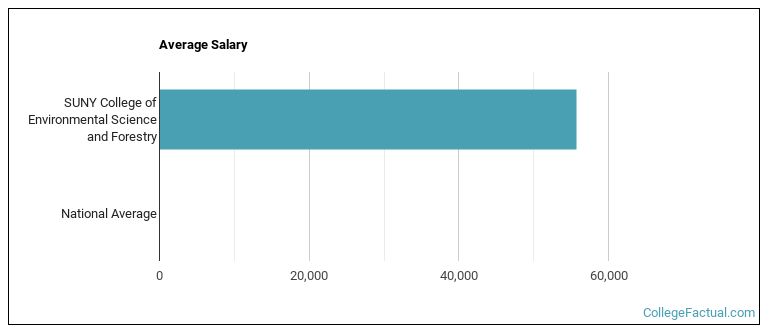 by our College Data Analytics Team
by our College Data Analytics TeamExplore the best ranked schools for the programs you are most interested in.
ESF was not ranked in College Factual's Best Overall Colleges report this year. This may be because not enough data was available.
See all of the rankings for SUNY College of Environmental Science and Forestry.
The acceptance rate at SUNY College of Environmental Science and Forestry is a competitive 70%, so make sure you take your application seriously when putting it together. Even leaving out a minor detail could be a reason to move you to the rejection pile.
The student to faculty ratio is often used to estimate how much interaction there is between professors and their students at a college or university. At SUNY College of Environmental Science and Forestry, this ratio is 13 to 1, which is on par with the national average of 15 to 1. That's not bad at all.
When estimating how much access students will have to their teachers, some people like to look at what percentage of faculty members are full time. This is because part-time teachers may not have as much time to spend on campus as their full-time counterparts.
The full-time faculty percentage at SUNY College of Environmental Science and Forestry is 72%. This is higher than the national average of 47%.
The freshmen retention rate of 79% tells us that most first-year, full-time students like SUNY College of Environmental Science and Forestry enough to come back for another year. This is a fair bit higher than the national average of 68%. That's certainly something to check off in the good column about the school.
Students are considered to have graduated on time if they finish their studies within four years. At ESF the on-time graduation rate of first-time, full-time students is 66%. That is great when compared to the national average of 33.3%
During the 2017-2018 academic year, there were 1,754 undergraduates at ESF with 1,625 being full-time and 129 being part-time.
| $0-30 K | $30K-48K | $48-75 | $75-110K | $110K + |
|---|---|---|---|---|
| $11,892 | $13,801 | $20,035 | $21,818 | $23,932 |
The net price is calculated by adding tuition, room, board and other costs and subtracting financial aid.Note that the net price is typically less than the published for a school. For more information on the sticker price of ESF, see our tuition and fees and room and board pages.
While almost two-thirds of students nationwide take out loans to pay for college, the percentage may be quite different for the school you plan on attending. At ESF, approximately 53% of students took out student loans averaging $7,196 a year. That adds up to $28,784 over four years for those students.
Get more details about paying for SUNY College of Environmental Science and Forestry.

See which majors at SUNY College of Environmental Science and Forestry make the most money.
Get more details about the location of SUNY College of Environmental Science and Forestry.

Contact details for ESF are given below.
| Contact Details | |
|---|---|
| Address: | One Forestry Dr., Syracuse, NY 13210 |
| Phone: | 315-470-6500 |
| Website: | www.esf.edu/ |
| Most Popular Majors | Bachelor’s Degrees | Average Salary of Graduates |
|---|---|---|
| Ecology, Evolution & Systematics Biology | 119 | NA |
| Natural Resources Conservation | 116 | NA |
| Forestry | 63 | NA |
| Environmental Engineering | 48 | NA |
| Natural Resource Management | 46 | NA |
| Zoology | 33 | NA |
| Landscape Architecture | 23 | NA |
| Construction Management | 20 | NA |
| Biomedical Engineering | 15 | NA |
| Biotechnology | 13 | NA |
Online courses area a great option for busy, working students as well as for those who have scheduling conflicts and want to study on their own time. As time goes by, expect to see more and more online learning options become available.
In 2022-2023, 242 students took at least one online class at SUNY College of Environmental Science and Forestry. This is a decrease from the 338 students who took online classes the previous year.
| Year | Took at Least One Online Class | Took All Classes Online |
|---|---|---|
| 2022-2023 | 242 | 41 |
| 2021-2022 | 338 | 63 |
| 2020-2021 | 1,804 | 413 |
| 2018-2019 | 65 | 10 |
Learn more about online learning at SUNY College of Environmental Science and Forestry.
If you’re considering SUNY College of Environmental Science and Forestry, here are some more schools you may be interested in knowing more about.
Curious on how these schools stack up against ESF? Pit them head to head with College Combat, our free interactive tool that lets you compare college on the features that matter most to you!
Footnotes
*The racial-ethnic minorities count is calculated by taking the total number of students and subtracting white students, international students, and students whose race/ethnicity was unknown. This number is then divided by the total number of students at the school to obtain the racial-ethnic minorities percentage.
References
More about our data sources and methodologies.